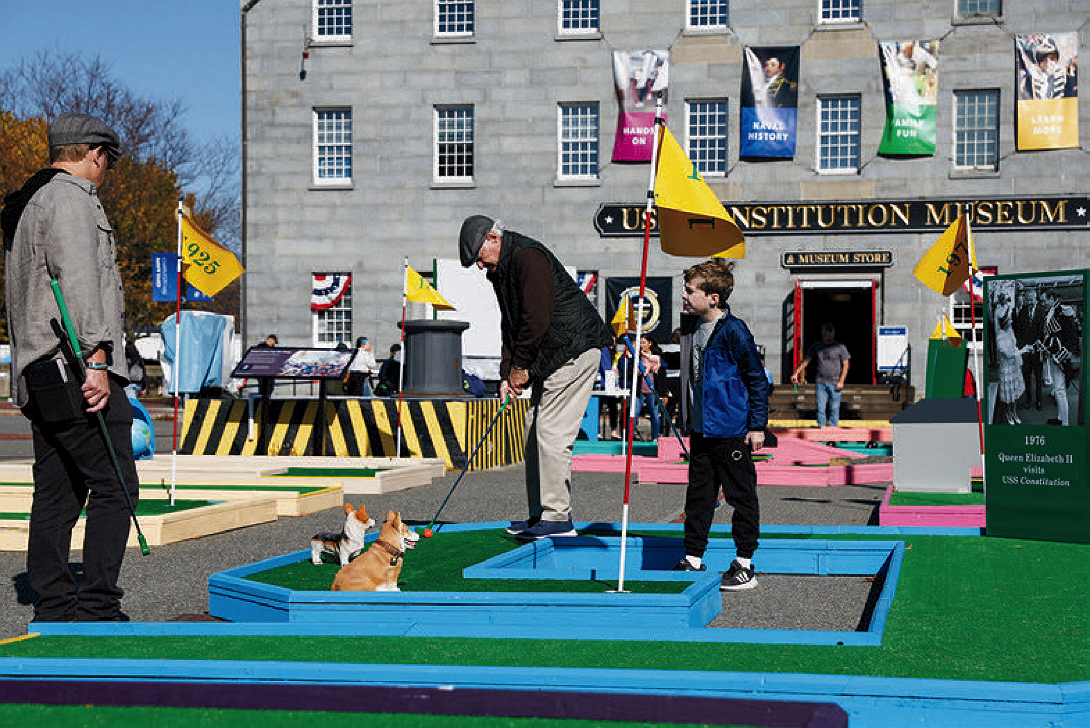Boston’s iconic USS Constitution, a 1790s warship that is the oldest active-duty boat in the world, is often taken for granted. But a recent stroll through the USS Constitution and its museum revealed a surprisingly fresh and interesting experience for all ages. The site enlivens and commemorates serious history while entertaining visitors with games and exhibits. As a grandfather gratefully emailed the museum, “You managed to keep two octogenarians and three teenagers engaged for two hours. That’s not easy.”

The USS Constitution Museum assumes no prior knowledge. An introductory film explains that the USS Constitution was launched in 1797 to protect American merchant vessels and grew in fame during the War of 1812 when it won three marquee battles against England. One sailor, remarking how cannonballs seemed to bounce off the ship’s oaken hull, remarked, “Huzzah! Her sides are made of iron!” Returning stateside after the war, the victorious “Old Ironsides” became a national symbol.
The opening exhibit poses two simple questions: Why does a country need a navy? And how should a young nation construct one? Those ideas are explored both through classic wall panels and hands-on activities. An interactive survey asks whether the nascent United States should “pay enemies for safe passage,” “buy protection,” or “build a navy.” A board game features an enemy ship chasing a U.S. vessel, while a video game has players design ships and battle each other. These games are not just for kids. Director of visitor experience Chris Kauffman says he has often heard U.S. Navy midshipmen at the controls “yelling at each other, saying, ‘I beat you!’”

Through portraits, artifacts, and wooden cutouts of reenactors, visitors learn about the crew. Researchers found a black Bostonian who, later in his naval career, abandoned ship in Alabama and was captured as a supposed fugitive slave; a Greek orphan who joined the Constitution as a ten-year-old, initiating a 53-year naval career; and a twelve-year-old boy who was blown overboard when a boiler exploded. These narratives, says longtime museum president Anne Grimes Rand, “help to make a ship which seems so distant from today feel real.”
After visiting the nonprofit museum, which opened in 1976 and operates independently, guests can meander through the Navy Yard and its visitor center, both maintained by the National Park Service. Then, they can hop on the real deal.
From any angle, the Constitution feels grand. Its huge jet-black hull, ornamented with white molding, looks young. On the top deck, visitors can imagine a flurry of activity—soldiers cleaning the cannons, adjusting the sails, climbing up to the roost. That broad sunny deck feels inviting. Perhaps a tour around the world would be fun. But descending the two lower decks—each with a lower ceiling than the last—paints a more realistic picture. A sign denotes where the chef would cook the daily stew (far from appetizing). Dozens of crowded hammocks show the uncomfortable sleeping arrangements, where diseases ran rampant. And the current aroma of polished wood is surely much more pleasant than the smells of yore.

But seven times a year, people need not just imagine what an in-service Constitution would have looked like. From spring to autumn, the ship takes periodic tug-powered jaunts into Boston Harbor, firing celebratory blanks. A cadre of active-duty Navy midshipmen and historical reenactors man the ship, some in period garb. On October 21, the ship will celebrate its 227th birthday with a cruise to Fort Independence. Although visitors can’t board the ship then, they can view the journey—and the salute—from Castle Island, Boston’s Harborwalk, or the Navy Yard (where there will be a launch party, featuring crafts and lawn games).
The site, which serves as the penultimate stop on the Freedom Trail, is a lively presence in Charlestown. Families compete on a free mini-golf course with nine holes, each representing a significant event in the Constitution’s history. Children gather to make tin foil boats. The crew fires a cannon blank each morning and evening. Newly enlisted Navy midshipmen learn how to operate cannons and fire muskets.

Between the museum, park grounds, and ship itself, the USS Constitution might be more alive now than ever. Once she finished her first mission—defending the country—she was granted a second life, sharing otherwise untold stories about the early American military.
For those who haven’t visited in years, museum president Rand encourages a second look. “I think our nation needs national symbols right now,” she says. “This is a symbol which is not political….A ship named for the document that every sailor still pledges their allegiance to when they join the Navy, was built in Boston…and sailed from this port undefeated. There’s a lot you can be proud of.”
And within that pride, there is fun, too.









